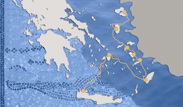The castle
The first fortifications at
Rhodes were built in the late 5th
century BC, at the time the town was founded. Since then many centuries have
elapsed, during which the defences have been extended, remodelled, destroyed,
repaired and reinforced, all contributing to the castle’s present-day
appearance. It owes much of its present form to the Knights of St. John, who occupied
the island in the early 14th century and stayed there until it fell
to the Ottomans in 1522. The castle’s Byzantine phases intervened between the
fortifications of ancient times and those of the Knight’s era. The first of
these, dating to the late 7th century, is associated with the Arab invasion of
the Aegean and systematic raids against the
islands. The second, in the late 11th and mid 12th century,
is linked to Rhode’s emergence as a major Venetian trading station, following
permission granted by Emperor Alexius I Comnenus . The walls were then extended
southward and gradually reinforced, so that the Hospitallers found themselves
up against considerable fortifications during the siege of Rhodes
in the early 14th century. In this phase the walled city was divided
into three areas: the citadel, the inner castle (Chollacium), and the Chora
or town proper (Burgus).
. The walls were then extended
southward and gradually reinforced, so that the Hospitallers found themselves
up against considerable fortifications during the siege of Rhodes
in the early 14th century. In this phase the walled city was divided
into three areas: the citadel, the inner castle (Chollacium), and the Chora
or town proper (Burgus).
The arrival of the Knights heralded
an era of prosperity and intense building
activity for Rhodes. Many Grand Masters, such
as Hélion de Villeneuve (1319-1346), Antoni di Fluvià (1421-1437), Jean Bonpart
de Lastic (1437 -1454) and Jacques de Milly (1454-1461), carried out projects
to repair, reinforce and extend the city walls until they acquired their
present length in the mid-15th century. They are about 3.5 km long
and enclose an area of 350 hectares. Byzantine
sections have survived at certain points in the ramparts, consisting of
earthworks and a ditch 20-60 metres wide. Twenty-one strong towers and eight
bastions reinforced the walls, in line with the demands made by the
introduction of gunpowder weapons, while numerous gates enabled free movement
and communication. The castle’s main thoroughfare was the paved Street of
Knights, 200m long and 6m wide. It began at the Palace of the Grand Magister
and ended at Our Lady of the Castle, a Byzantine church modified by the
Knights. The street was lined on either side with the most important buildings
in the castle - the Church
of St. John in the
Collachium, the Inns of Tongues, the Chapel of the Holy Trinity, the
Hospital and residences of officials in the Order.
of the Holy Trinity, the
Hospital and residences of officials in the Order.
The fall of Rhodes to the
Ottomans under Suleiman the Magnificent in 1522 did not result in significant
changes to the appearance of the wall, but was reflected in the castle interior
by the building of mosques dedicated to Hamza Bey, Suleiman and others.
Bibliography (8)▼
Comments (0)▼
New Comment▼






















